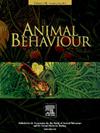Human activity selectively affects a dynamic defensive mutualism
IF 2.3
2区 生物学
Q2 BEHAVIORAL SCIENCES
引用次数: 0
Abstract
Human presence and urbanization alter many species' vulnerability and perceived risk, but little research has investigated how anthropogenic impacts affect behaviour in dynamic defensive mutualisms. As human activities continue to expand in marine communities, it is important to understand how they may affect risk assessment in behaviourally dependent symbionts. Shrimpgobies (Ctenogobiops spp.) and snapping shrimp (Alpheus spp.) in Mo'orea, French Polynesia participate in an obligate, symbiotic relationship in areas where humans recreate. We quantified hiding time, flight initiation distance and time allocated to different behaviours to first describe this defensive mutualism, then determined whether human activity directly impacted it. We found that goby behaviour significantly explained variation in shrimp behaviour. Specifically, shrimp varied in how long they remained in their burrow, how long they remained in their burrow after their goby partner(s) emerged, the rate at which they excavated their burrows and the time spent outside their burrows as a function of goby behaviour. Our findings suggest this dynamic mutualism was selectively affected by humans. Human activity, measured by both presence and abundance, explained some variation in multiple goby behaviours that directly influence variation in shrimp behaviour.
人类活动选择性地影响动态防御性互惠关系
人类的存在和城市化改变了许多物种的脆弱性和感知风险,但很少有研究调查人为影响如何影响动态防御性共生体的行为。随着人类活动在海洋生物群落中的不断扩大,了解人类活动如何影响依赖行为的共生体的风险评估非常重要。法属波利尼西亚莫奥里亚的虾虎鱼(Ctenogobiops spp.)和鳄虾(Alpheus spp.)在人类活动区域内形成了一种强制性共生关系。我们量化了虾虎鱼的躲藏时间、飞行起始距离和分配给不同行为的时间,首先描述了这种防御性互惠关系,然后确定人类活动是否直接影响了这种关系。我们发现,虾虎鱼的行为可以很好地解释虾行为的变化。具体来说,虾在洞穴中停留的时间、虾虎伙伴出现后在洞穴中停留的时间、挖掘洞穴的速度以及在洞穴外停留的时间都与虾虎的行为有关。我们的研究结果表明,这种动态互惠关系受到人类的选择性影响。人类活动(从存在和丰度两方面衡量)解释了虾虎鱼多种行为的一些变化,而这些行为会直接影响对虾行为的变化。
本文章由计算机程序翻译,如有差异,请以英文原文为准。
求助全文
约1分钟内获得全文
求助全文
来源期刊

Animal Behaviour
生物-动物学
CiteScore
4.60
自引率
8.00%
发文量
236
审稿时长
10.2 weeks
期刊介绍:
Growing interest in behavioural biology and the international reputation of Animal Behaviour prompted an expansion to monthly publication in 1989. Animal Behaviour continues to be the journal of choice for biologists, ethologists, psychologists, physiologists, and veterinarians with an interest in the subject.
 求助内容:
求助内容: 应助结果提醒方式:
应助结果提醒方式:


